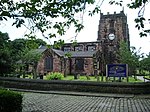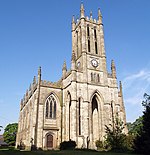John Wallwork (aviator)
1898 births1922 deathsAviators killed in aviation accidents or incidents in EnglandBritish World War I flying acesPages containing London Gazette template with parameter supp set to y ... and 4 more
People from Radcliffe, Greater ManchesterRecipients of the Military CrossRoyal Air Force officersRoyal Flying Corps officers
Flying Officer John Wilson Wallwork (1898 – 18 December 1922) was a British World War I flying ace credited with five aerial victories.
Excerpt from the Wikipedia article John Wallwork (aviator) (License: CC BY-SA 3.0, Authors).John Wallwork (aviator)
Rectory Close,
Geographical coordinates (GPS) Address Nearby Places Show on map
Geographical coordinates (GPS)
| Latitude | Longitude |
|---|---|
| N 53.564166666667 ° | E -2.3080555555556 ° |
Address
Rectory Close
M26 2PB , Irwell Bank
England, United Kingdom
Open on Google Maps






